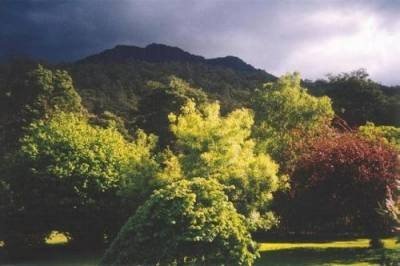
This memorial is at Flinders Cemetery on Westernport Bay, the eastern side of the Mornington Peninsula.
I was intrigued by the "poet and teacher" caption. Time to do a Google journey.
Selwyn Hughes migrated from Wales to Australia.
He discovered that an aboriginal poet had the name of Selwyn Hughes, so he wrote under the name of Selwyn Pritchard.
Selwyn's own website - including his biography and audios of poems - is HERE!
But there is more intrigue surrounding this grave!

It is covered with shells and even a couple of shell necklaces.
And they are loosely placed on the grave.
I did another Google journey.
Apparently, a large number of graves in Texas have shells, but the the shells are fixed.
One website suggests it is a pre-Egyptian practice - stones and coins fall in this category.
(There are a few smooth stones mixed in with the shells!)
Many websites believe that the shells symbolise some form of after life, even re-incarnation.
But I like the idea a few websites propose - that the seashells are symbols of the sea.
(And Flinders is right by the Tasman Sea which becomes the Pacific Ocean.)
The sea carried him here and will return him home...perhaps connected with the tragedy in the UK!


Here is one of Selwyn's poems In The Sleep of Reason:
Like an owl in the ruins of truth I lament
Not the embarrassments of youth
Nor agonies of middle age
But that In my dotage I should see
The triumph of demagoguery
Merciless aggression and the future
Repeating the past
Let my voice trouble
The glutted sleep
Of the righteous.
*********
Here is my haiku response:
In beauty's shambles
May the owl's silent wisdom
Shower some pure light*********


Taphophile Tragics is hosted by Julie
Click on the badge to view MORE!






9 comments:
Fascinating post for the day, Gemma! He was born on my birthday! Love the shells! Beautiful words as always! Hope your week is off to a great start!
Sylvia
I like the simple wording of the gravestone, and the shells.
I agree with Sylvia - a very interesting post Gemma - we never know what we will uncover while rambling around old cemetries.
Thank goodness for Google!!
Oh! and I love the shells - I would like to think that it's about the sea.
I think that is one of the most beautiful graves I have seen.
A wonderful idea for people who love the sea.
A lovely post and you have got me interested in his history and tragedy. The shells are a good idea for whatever reason. I remember visiting your post years ago.
As soon as I saw the shells, Gemma, I thought 'a midden'. Then I saw the link with an indigenous poet of the same name ...
I have a Welsh grandmother, and named one of my cats Selwyn, I kid you not. I call her Sellie for short.
That is very sad about their 11 yo eldest child. An uncle of mine died when hit by a taxi stepping out from the curb in London in 1956. Broke my grandmother's heart ...
Thank you for your continued contribution to Taphophile Tragics. It is good to hear your 'voice' on a regular basis.
The shells immediately reminded me of the pilgrim symbol for the Camino de Santiago de Compostela. It would be a poetic gesture for a visitor to lay a shell on his grave. Like adding a stone to a cairn. Probably not the explanation, but I like the idea anyway.
A terrific and fascinating post, Gemma! I've never seen a grave covered in shells before, and I like the concept. Nice haiku, too.
It may be a tenuous (or even irrelevant!) connection - but in many South Pacific countries, the shell is used as currency, with large shells like the one in your last photo also used like a trumpet!
What a shame he didn't leave something behind to explain it all! Then again - maybe leaving it to our imagination is more appropriate for a poet!
Post a Comment